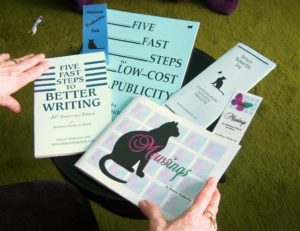 by Barbara Florio Graham
by Barbara Florio Graham
As a professional speaker and teacher, I’ve given three-day workshops to Canadian federal government departments that paid me $1,000/day, international conferences where the payment was in prestige and a lovely gift, national conferences that paid a speaker’s fee plus comped registration and meals, and local groups, wheree compensation was a small honorarium and the opportunity to sell my books.
Know what? The best experiences have not been at those high-priced workshops, nor were the smoothest arrangements at international or national conferences.
Well-paid event planners don’t always do better than volunteers. And it’s often up to you to ensure that things run smoothly.
Here’s a checklist I use:
- Confirm the date and time early, and give organizers a deadline after which they can’t cancel or change your date/slot unless exceptional circumstances arise.
- Make sure you obtain full contact information, with back-up email addresses and phone numbers. Send a bio and a description of the presentation, and check to see that it’s been received.
- Request any special requirements, such as a projector and screen, flip charts, or a white board. I never rely on electronics to work properly, and don’t like PowerPoint in any case, so I always ask for two flip charts.
- Do you want a special configuration in the room (theatre style, participants at tables, a circle)? Find out if the organizers will photocopy your handouts, and prepare them early so you can send them well in advance. Do you prefer a table or a podium? I always prefer a table, as I’m more visible standing behind a table, and it allows me to move around more. But they may require that a podium with a microphone be used.
- Two weeks in advance: obtain the final conference program or the agenda if it’s a single event. Confirm cell phone numbers, room arrangements, and requested equipment; ensure they have the materials you’ve asked to be photocopied.
- The week before: are handouts ready and are you sure the person assigned to you has them? I always carry the following with me: a set of originals of my handouts; a copy of my bio; and a brief introduction I’ve prepared, in case the person introducing me doesn’t show up or isn’t prepared; flip-chart markers; and my own filled water bottle with a straw. I make sure I have a few paper towels and extra tissues. I also wear my own badge, which is especially important if they’ve misspelled your name on the one they prepared!
- Day before: set out your clothes. Wear something both visible and comfortable. Nobody looks at a speaker’s shoes (unless you’re on TV), so as long as they’re appropriate and shined, your most comfortable pair is essential. You need color near your face, so if your jacket is dark, wear a bright blouse or scarf (men need a colored shirt and fairly bright tie).
- Day of: arrive early. Find the washrooms, snag an extra chair to park your coat and bag if they haven’t provided one beside the table or podium. Then greet people, relax, and enjoy your moment in the spotlight.
Barbara Florio Graham is an author and publishing consultant. Her website, www.SimonTeakettle.com, contains a great deal of free information, as well as Simon Teakettle’s popular blog. This article first appeared in Freelance Writer’s Report.
